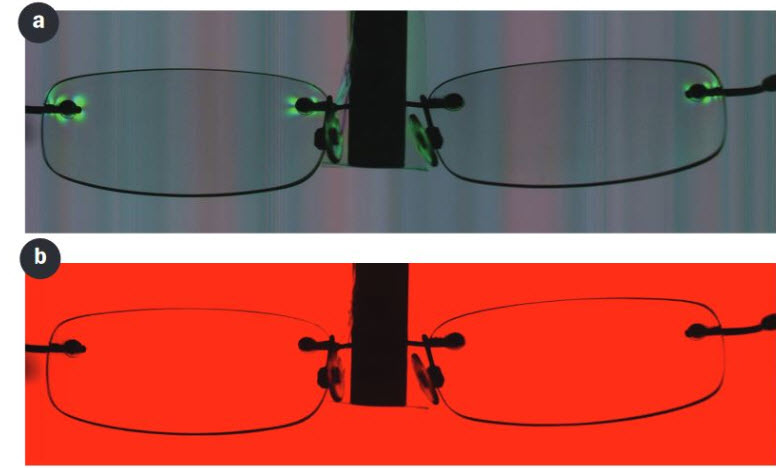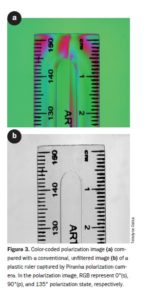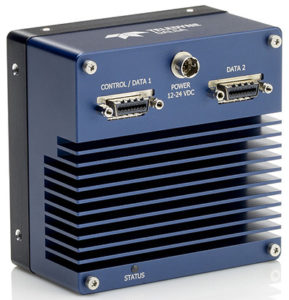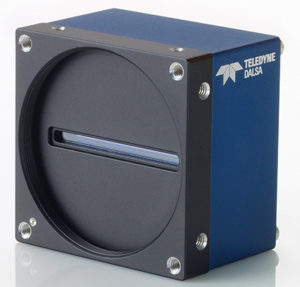
There are three fundamental proper-ties of light: intensity, wavelength and polarization. Almost all cameras today are designed for monochrome or color imaging. A monochrome camera is used to measure the intensity of light over a broadband spectrum at pixel level1, while a color or multispectral camera is used to detect the intensities of light at the red, green, blue and near-IR wavelength bands2,3. Similarly, a polarization line scan camera captures the intensity of light at multiple polarization states.
Polarization offers numerous benefits, not only detecting geometry and surface, but measuring physical properties that are not detectable using conventional imaging. In machine vision, it can be used to enhance contrast for objects that are difficult to distinguish otherwise. When combined with phase detection, polarization imaging is much more sensitive than conventional imaging.
Line scan polarization cameras using micropolarizer filters overcome the shortcomings of other tehniques like division of time and division of amplitude. In line scan, multiple arrays with different polarization filter orientations capture images simultaneously but at slightly different positions. Spatial correction allows the camera to align all channels at the same object point. The advantage of line scan over area scan is that it provides multiple native polarization state data without any digital manipulation
Teledyne Dalsa’s Piranha polarization camera incorporates a CMOS sensor with a quadlinear architecture. A micropolarizer array consisting of nanowires is placed on top of the silicon; the nanowires have a pitch of 140 nm and a width of 70 nm, while the orientation of the micropolarizer filters is 0°, 135° and 90°, respectively, on the first three linear arrays. The intensity of the filtered light is recorded by the underlying arrays. Thefourth channel is an unfiltered array, which captures the total intensity, equivalent to a conventional image, while the gaps in between the active arrays reduce spatial crosstalk.
Image visualization
Polarization images are largely uncorrelated to conventional images based on inLinetensity. In a vision system, data processing could be implemented in each specific polarization state or their combinations. It’s useful to have a representation of polarization images considering human’s inability to see it. Color-coded polarization images are probably the most popular as they not only give visual perception but also utilize the standard data structure and transfer protocols in color imaging.
Figure 3 shows a color-coded polarization image of a plastic ruler captured by the Piranha polarization camera, where RGB represent 0° (s-polarized), 90° (p-polarized) and 135° polarization state, respectively. A conventional image captured by the unfiltered channel is also compared. Obviously, the polarization imaging reveals built-up stress inside the plastic ruler that cannot be detected by conventional imaging.
Detectability
Today, the machine vision industry is facing many challenges in detectability as speed reaches to about a 100-kHz line rate and object resolution shrinks to submicron. Different technologies have been developed, such as time delay integration to improve signal-to-noise ratio, and color and multispectral imaging to obtain spec-tral characteristics. However, higher con-trast is required based on the physical properties of materials. Polarization plays a key role here as it is very sensitive to any change on the surface or interface. Because of phase detection, polarization-based imaging is much more sensitive than intensity-based imaging.



In summary, by combining high sensitivity of polarization phase detection and truly lateral resolution, line scan polarization imaging provides the detectability for next-generation vision systems in many demanding applications.
Teledyne DALSA has introduced Piranha4 Polarization™ camera which is a breakthrough in the machine vision industry. This high-speed polarization camera features three native polarization states plus an unfiltered channel.
The Piranha4 polarization camera extends detection capability in machine vision and is ideal for detecting stresses, surface roughness, film thickness, alloy composition, and 3D profiles.
Note: These cameras are marked as End of life products or legacy. The above is only for technical info.
We'll be glad to help you! Please contact our Sales Team for more information.
We'll be glad to help you! Please contact our Sales Team for more information.